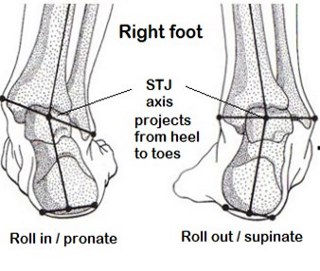Podiatrists - the Goto Gait Geeks
- Nov 23, 2019
- 4 min read
Written By Mr David Smith Podiatrist MSc Applied Biomechanics
How important is the sub talar joint axis?
The sub talar joint and its axis: Part of the ankle joint complex it plays a significant role in the mechanics of your foot.
If you imagine your ankle joint allows your foot to flex up and down around the axis of the joint, then the sub talar joint lies beneath and perpendicular to the ankle joint and it allows your foot to tilt or roll from side to side as it moves around its axis. This motion is commonly called pronation and supination, you've probably heard of pronation before especially if you are a runner.
Many running shops will advise on shoe type based on the degree of pronation, this simple observation can be a valid and useful indicator of foot functioning terms of shoe choice but often the whole mechanism is poorly understood in terms of why the pronation is happening.
This why consulting with a professional who fully understands foot and lower limb function is optimal and sometimes critical in achieving the best outcomes in terms of resolving pain and injury and improving performance.
Here's a case in point: A lady came to see us at FootHouse for Gait Analysis because she felt her walking was unbalanced and her feet unstable and wobbly, walking any distance was becoming a problem.
At first evaluation both feet were very pronated in standing and walking and this rolling in action was very heavy so that the inside of the foot was hard on the ground.

Now remember our sub talar joint (STJ) axis, ideally this axis bisects the centre of the length of the foot and ankle. When the foot is rolled hard over in pronation it is often an indication that the STJ is more towards the inside of the foot and so when the foot is on the ground the force from the ground on the foot has a large lever to act on and roll the foot inwards. Often in this case an anti-pronation shoe will be advised or an insole that has a medial wedge that tends to roll the foot outward, i.e. supinates the foot on the STJ, in order that the foot has an improved posture or position that is less pronated.
For those engineers out there, even though a positional change is sometimes required, a change in position is an intuitive description but not a necessary action required to reduce the internal tissue stress that results in trauma and pain. An orthotic (special type insole) design will change the direction, magnitude and timing of the externally applied forces, which will change internal forces and moments and the stress in body tissues, muscles, tendons, ligaments etc, that must resist those forces but not necessarily change position significantly.
In this particular case however, the STJ axis was very lateral i.e. towards the outside of the foot. It is usual for feet with lateral STJ axis to supinate too much, however what can happen in some cases, as it was in this case, the opposite is actually observed.

Why?
The answer is 'The action of the Peroneals': the peroneals are a group of muscles that cross the ankle on the outside and when activated make the foot pronated or roll in. In some people with lateral stj axis the central nervous system will notice the tendency to supinate and in an effort to avoid inversion sprains of the ankle will fire the peroneal group to pronate the foot. Now the peroneal group normally fires when walking but it must come at the correct time, usually this is towards the push off phase, which is as you lift the heel of the ground and push thru your toes. In this lady's case the peroneals started firing as soon as she stood up and was weight bearing and so the foot heavily rolled in despite the lateral stj axis position.
So, the problem of balance and instability she experienced was because the rolling in or pronation tends to disrupt the optimal progression and posture of gait (NB gait is the term for the actions of walking and running). But, the peroneal muscles are small and when they are used over a long time period and with the sustained effort they require to avoid uncontrolled rolling out and inversion sprains of the ankle, then they become tired and less effective. Therefore, on longer walks the less effective the peroneals become and the feet tend to roll out and she becomes unstable.
We observed that the feet heavily pronate but because we further evaluated the mechanics of her feet we were able to prescribe the correct design for her orthotics. The correct design was to put lateral wedges, lifting the outside of the feet, that would roll the feet inward, which to the casual observer may seem counter intuitive, but having read this you will understand that fitting medially wedged orthoses or anti-pronation running shoes would be disastrous, possibly leading to falls and ankle sprains and much more unbalanced gait progression.
Upon fitting the correctly designed orthotics the lady's feet regained a more upright position, as central nervous system detected that the peroneal muscles did not need to fire abnormally to maintain stability, and a more optimal gait progression was restored and she felt balanced and comfortable and looked forward to getting back to longer walks again.
Good outcomes really do need an expert intervention, podiatrists, trained in biomechanics and musculoskeletal evaluation of the lower limb, are the goto gait geeks.




Comments